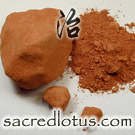Chi Shi Zhi (Halloysite, Kaolin)
Herb 2 of 22 in Herbs that Astringe, Stabilize, Bind
Buy This Herb
Get free shipping from
our partners at CHD
our partners at CHD
Chinese Herb Actions
-
Binds the Intestines, Supplements Qi, and Stops Diarrhea
For unremitting chronic diarrhea from Qi Deficiency and Cold, with additional Qi Deficiency signs such as lethargy, general weakness, and dull abdominal pain.
For chronic dysentery with such symptoms as blood and mucus in the stool.
For rectal prolapse due to Spleen Qi Deficiency. - Stops Bleeding
For bleeding due to Kidney and Liver Deficiency causing Cold in the Lower Jiao. Symptoms include excessive uterine bleeding, spotting between menstruation times, bloody stools, or anal bleeding due to prolapse. - Generates Flesh and Promotes Healing of Wounds and Sores
For chronic ulcers that do not heal. This herb can also be used topically for bleeding or weeping Damp sores.
Chinese Herb Contraindications & Cautions
- Do not use in cases of Excess Damp Heat or Stagnation.
- Do not use in cases of hot diarrhea.
- Do not use in the early stages of Dysentery.
- Use with the utmost caution in pregnancy
Herb-Drug Interactions
- Chi Shi Zhi has the ability to bind to other substances in the gastrointestinal tract forming a solid mass that has limited absorption in the intestines. For this reason, drugs should be taken a few hours before or after the ingestion of Chi Shi Zhi. 12
Chinese Herb Toxicity & Overdose
- No toxicity noted.
- Overdose may cause vomiting and nausea
- Section not completed...
Chinese Herb Dosage
- 9-18 grams 13
- 10-20 grams, with a maximum of 30 grams 12
Chinese Herb Notes
- Chi Shi Zhi is traditionally used as an antidote for ingestion of poisonous substances as it binds to the poison and eliminates it through the bowels.
- As this herb primarily treats to branch of the problem, tonifying substances should be added to treat the underlying Deficient root.
This Herb Appears in the Following Formulas:
- Tao Hua Tang (Peach Blossom Decoction)
Category: Formulas that Restrain Leakage from the Intestines - Zhen Ling Dan (Rouse the Spirit Special Pill)
Category: Formulas that Stabilize the Womb
This herb antagonizes or is antagonized by:
- Rou Gui (Cortex Cinnamomi Cassiae)






